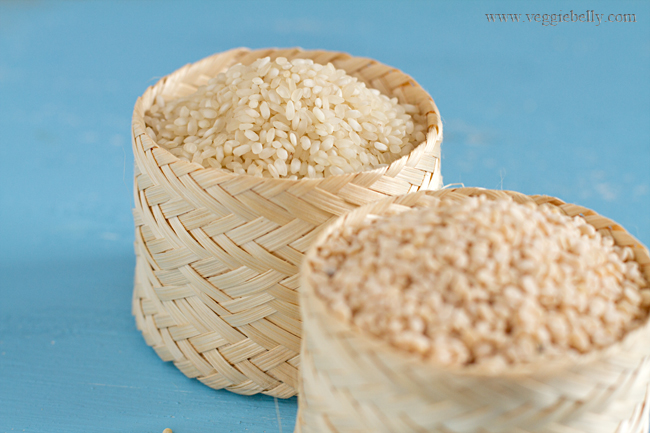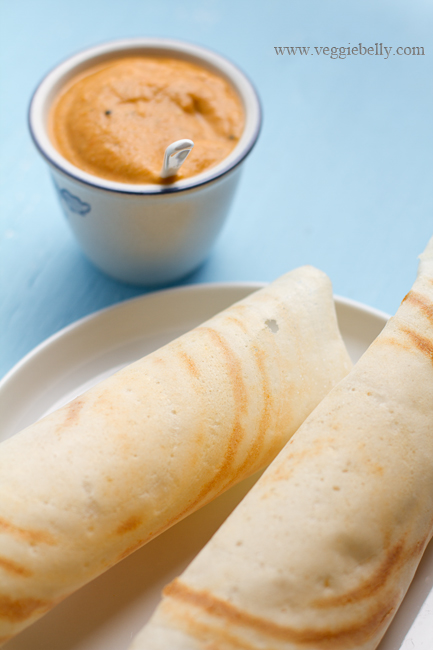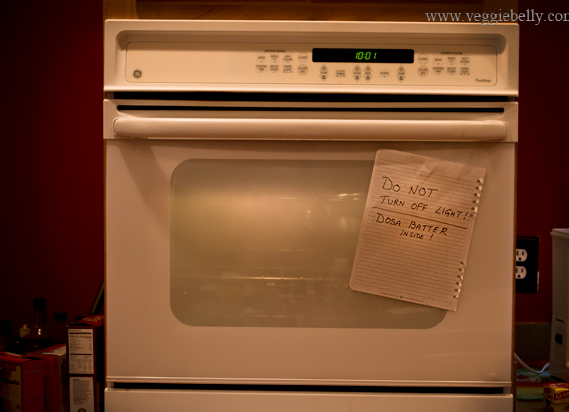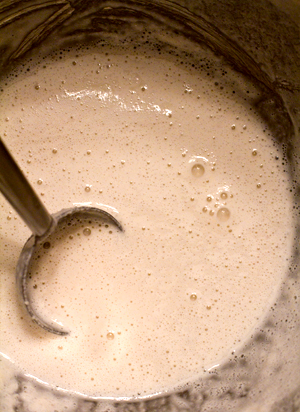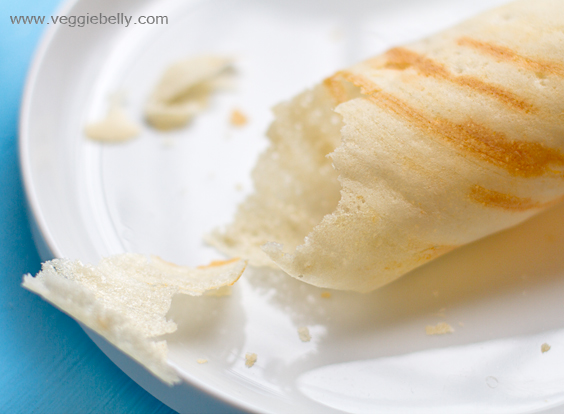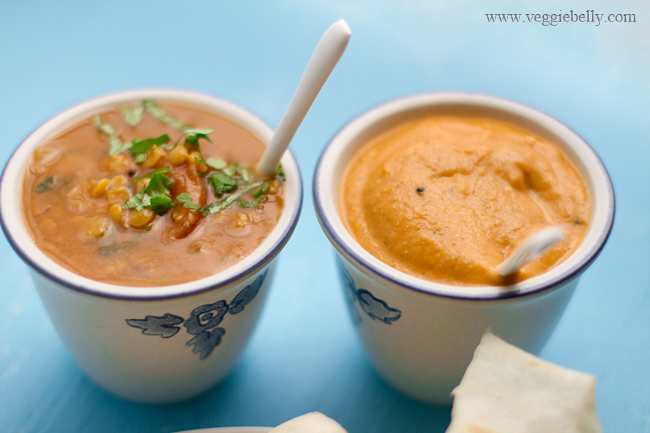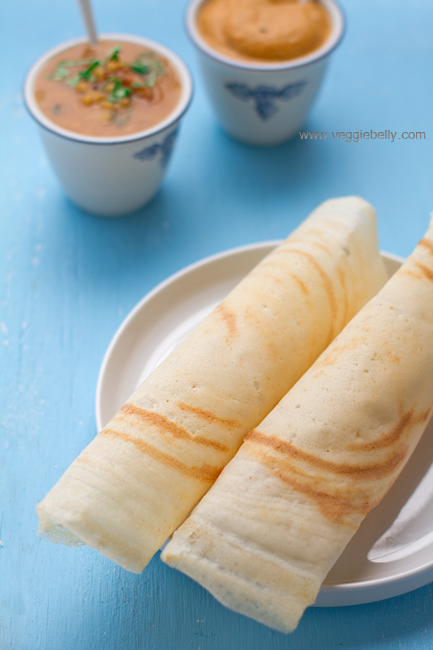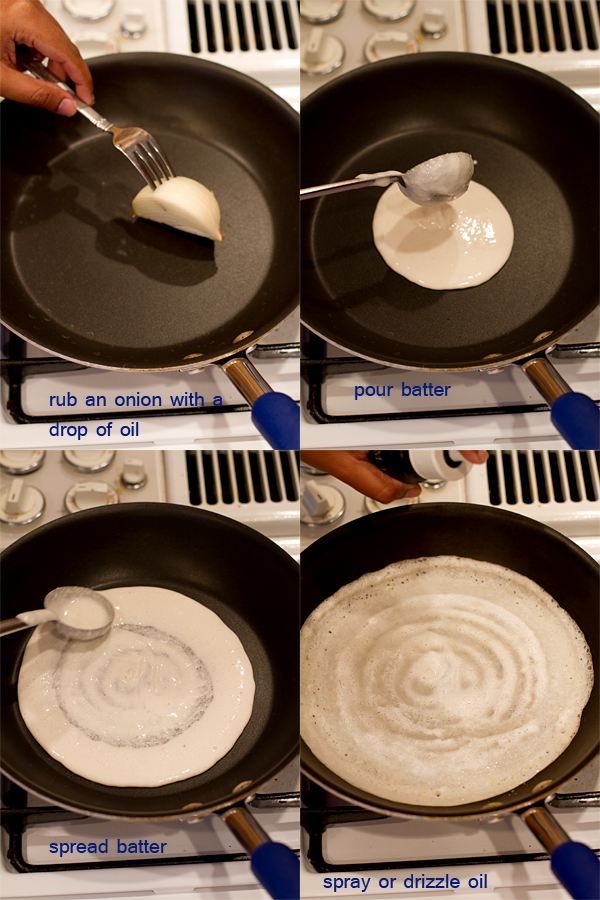The Perfect Dosa Recipe (Rice and Lentil Crepes)
By | MARCH 28, 2011
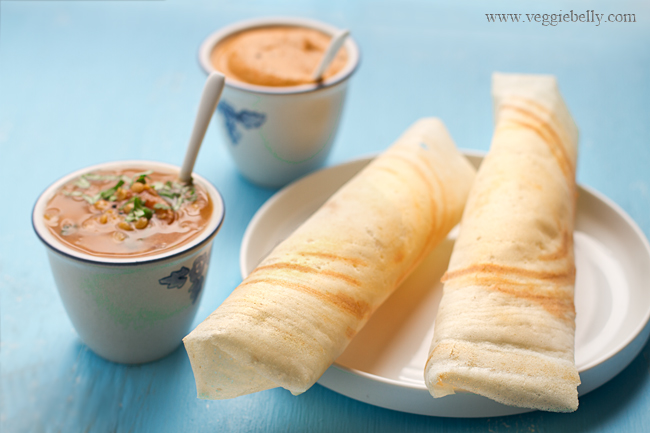
(Pic courtesy: Veggiebelly)
Perfecting my dosa recipe and method hasn’t been easy. It took a lot of experimentation, but finally I have the best dosa batter recipe and method for you. Read on to learn hot to make the perfect dosa-idli batter recipe, a dosa grinder giveaway, and your questions about dosa and idli batter answered by the experts!
Dosa, Idli Dos and Don’ts
Do use a hot griddle for dosas
Do use your hands to mix the ground batter
Do use whole urad dal (urad gota)
Do use a wet grinder or other similar heavy duty grinder/blender for the batter
Do place the batter in 80-90 degrees F for fermentation
Do experiment with various types of rice and urad dal to find what suits you best
Don’t pour dosas using cold batter
Don’t make dosas on an unseasoned pan (see recipe below for the onion trick)
Don’t use poor quality rice and dal
Don’t use an air tight lid when batter is fermenting
Your Dosa and Idli Batter Questions Answered by the Experts
Ive talked to several people about the art and science that is dosa-idli making. For this post, we have two of the most knowledgeable people on this topic to answer your idli, dosa questions.
Chef KN Vinod, is an award winning restaurateur who runs three of Washington DC’s favorite Indian restaurants Indique, Indique Heights and Bombay Bistro. At his restaurants, Chef Vinod regularly hosts celebrities and politicians including (KR Narayan and Hillary Clinton!). Chef Vinod blogs at http://chefvinod.typepad.com/. You can also find him on twitter and facebook. For today’s Q&A, Chef Vinod has elicited the help of his friend, and food scientist Dr. Danny Chawan.
Ms. Andal Balu is the owner of Atlanta based Inno Concepts, a company which sells kitchen appliance for Indian cooking. Mrs Balu is a successful business woman, gourmand, and America’s expert on dosa/idli making. Inno Concepts is the generous sponsor of today’s grinder giveaway.
My idli and dosa batter doesn’t fermentation properly. I let the batter sit in the oven with the light on overnight and it is completely unchanged even 10 hours later. Ive tried everything. Help!
Andal Balu: Use the soaking water to grind the rice and dal for proper fermentation. You have to mix the batter with your hand. If you mix it with ladle, it may not ferment right (body heat from your hands helps kickstart fermentation). Also cover the batter with a lid that fits loosely - do not use an airtight lid.
Chef Vinod: Fermentation is always a problem in colder places. Our modern living with air filters etc. also inhibits the capture of wild yeast from the air. Sometimes indoor air, particularly in winter with all the doors and windows shut will be low in air borne yeast cells. When all else fails, I would recommend using some yeast. Use half teaspoon in half cup water and a teaspoon of sugar to kick start yeast growth. Add to a gallon of batter.
Sala’s note: If you’ve tried everything, you might want to change your brand of rice and dal and see if that does the trick. Poor quality ingredients = poor quality fermentation.
In cold climates, place batter in an oven with the light on for warmth. Leave a note so no one turns off the oven!
What proportion of rice and ural dal do you personally use?
Andal Balu: I use the same proportion for idlis and dosas. 5 cups parboiled (idli) rice, and 1 cup whole urad dal (gotta). I make idlis with this batter the first day, dosa on the second, and uthappams on the third day.
Chef Vinod: At the restaurant we use 4 cups long grain rice, 1 cup parboiled (idli) rice, 1 cup urad dal, and a little methi seeds
Sala’s note: Everyones recipe will be different because quality of rice and dal used, quantity of batter made, and temperature all affect the ratio. Use these proportions as a guideline and then experiment.
Should I grind the rice and dal separately or together?
Andal Balu: Separately. Grinding dal separately will make it fluffy, resulting in excellent fermentation. It will also volumize the batter when fermenting which is important for fluffy, soft idlis.
What consistency and texture should my ground dosa and idli batter be?
Andal Balu: Grind dal till it is very soft and foamy. Also grind the rice till smooth. Add enough water to the batter so that it is thick, but when you scoop it in your hands, the batter falls through your fingers. This is what I do for both idli and dosa.
Does is matter if I use tap water or filter water for soaking and grinding?
Chef Vinod: If your tap water is highly chlorinated, it could inhibit fermentation. In this case, use filtered water.
Why do we use fenugreek or methi seeds in dosa-idli batter making?
Chef Vinod: Methi seeds contain compounds high in beta-glucans. They help hold carbon dioxide, which makes idlis fluffy and soft. Methi seeds also give viscosity to the batter.
If I rinse the dal, will it take away the necessary properties to ferment?
Chef Vinod: Washing is done to remove any dust, and impurities from the dal and rice. Althought some old time cooks soak the dal and rice without rinsing and wash just before grinding.
How much salt should I add to my dosa and idli batter?
Andal Balu: About 1/2 teaspoon for one cup of dry ingredients (rice + dal) plus more according to taste. Adding enough salt is important for proper fermentation.
How can I get good textured idlis at high altitude? What are the adjustments for altitude?
Andal Balu: The rice needs to be ground finer so it can cook faster at higher altitudes. If the rice is coarse, it will take longer to cook and will feel gritty in the mouth. Make sure a warm temperature is maintained when batter is fermenting.
Chef Vinod: I turned to Dr. Chawan for this. He says changing the proportion of dal and rice for higher altitudes isnt necessary. Fermentation is done by yeast, and yeast grows in high altitudes as well, and produces carbon dioxide which is the key component of making fluffy, soft idlis. Pay attention to the fermentation temperature; make sure your batter is in a warm place. A little glucose or corn syrup will also make your batter rise better.
My dosas always turn out dry and brittle, what am I doing wrong?
Andal Balu: Check the consistency of the batter – is it too thick? Check the temperature of the batter – make sure it is at room temperature, and not straight out of the fridge. Make sure that the pan is hot enough when you pour the batter. Check it by splashing couple of droplets of water on the pan and it should sizzle.
Chef Vinod: Two scientific reasons. 1. Not enough dal in your batter. Protein in dal is responsible for the softness. Try increasing your dal proportion. 2. Amylopectin in rice. According to Dr. Chawan, there are two kinds of starches present in rice and grains – Amylopectin and Amylose. If the rice is low in Amylopectin and high in Amylose it can cause the dosa to be dry and brittle. Sala’s note: Try experimenting with different brands of rice.
Ok, but there is no way I can determine the chemical composition of a bag of rice at the store. Is there a quick fix for dry and brittle dosas?
Chef Vinod: As a quick fix, if you have some tapioca flour handy, Dr. Chawan recommends trying to incorporate some into the batter as it is very high in Amylopectin. I have not personally tried it.
My idlis are pale yellow. How do I get white idlis?
Andal Balu: If the ground batter does not ferment properly, the idlis will be yellowish (see the question and answer on fermentation). Also make sure the consistency of the batter is right – once the urad and rice batters are mixed, take the batter in your hand, it must fall freely back into the vessel.
Chef Vinod: If your batch of urad dal has been contaminated with immature urad beans or partially germinated beans, this will produce some enzymes which will cause idlis to become yellowish or pinkish. Sala’s note: Try a different brand of dal.
I would love some tips on how to make paper thin, crispy dosas
Andal Balu: Grind the rice fine. Don’t use extremely thick batter. Use an iron skillet for best results. Bring refigerated batter to room temperature before making dosas. You can take it out of the fridge ahead of time. Or you can heat some water in the microwave and add to the thick batter to make it thin and to bring it to the room temperature. Between dosas, grease the tawa or skillet lightly with oil and then pour the batter. Add extra oil after the batter is poured on the skillet.
Sala’s note: I add chana dal (soak 3 tablespoons of channa dal with every cup of urad) for super crispy, golden, restaurant style dosas.
How do you get the nice golden color you seen in restaurant dosas?
Chef Vinod: Add a little besan (gram flour) in very less quantities that you cannot make out that besan has been added. OR, add a little sooji (cream of wheat) to make the dosa really golden and crisp. This again is done in very less quantities that you cannot make out.
Andal Balu: You will get nice golden brown dosas if you bring the batter to room temperature. If you use the cold batter, the dosas will stay white.
Sala’s note: I add channa dal (soak 3 tablespoon for every cup of urad dal) for golden colored dosas.
Why are my idlis hard and rubbery? How do I make soft and fluffy idlis?
Andal Balu: Keep four thing in mind for soft, fluffy idlis.
1. proper fermentation (see earlier questions)
2.proper rice:dal proportion
3.don’t overcook idlis, this will make them hard. Steam idlis for about 12 minutes if using a conventional idli steamer, and 15 minutes for an electric one.
4.never pressure cook idlis
What is the proper way to eat a dosa, what are the accompaniments, what do you dip it with? Is there a dosa etiquette?
Andal Balu: There is no dosa etiquette. Enjoy it however you want. Side dishes recommended – idli chilly powder, coconut chutney, tomato chutney, coriander or cilantro chutney, yogurt, Chinese garlic pickle, potato masala, sambar…possibilities are endless!
Chef Vinod: Dosa is made and served differently from region to region in India – so I would not say that a particular way is right or wrong. Most places in south India serve dosas with sambar and coconut chutney.
Sala’s note: Serve yourself a dosa on your plate. Pour sambar into cups, if they are available. Serve chutney, dosa or idli podi (also called gun powder) and potato masala on the plate. Tear off a piece of dosa and dip it into any combination of the sambar, chutney, podi and or potato. Lick your fingers, and enjoy ![]()
The Perfect Dosa Recipe
Serves about 8
1 cup sona masuri rice (or similar medium grained rice)
1 cup idli rice (parboiled rice)
½ cup whole urad dal (skinned black gram)
½ teaspoon methi seeds (fenugreek seeds)
Salt 1 teaspoon
Special equipemt: a wet grinder. This is a heavy duty grinder that is perfect for dosa and idli batter. You could use a blender instead, but the results wont be the same.
Place the rice in a large bowl. Place the dal and fenugreek seeds in another large bowl. Wash the rice with room temperature water. Drain out the water, and fill the bowl with more water, so that the water is about 2 inches above the rice.
Do the same with the dal and fenugreek – wash, rinse, and fill with water. Let rice and dal soak for about 6 hours.
The dal should now be swollen, and the rice will be easy to break with your fingers.
Pour about 2 tablespoons of the dal soaking liquid into a wet grinder. Turn the grinder on. Then, using your hands, scoop the soaked dal, allowing excess water to drain back into the bowl. Add dal to the grinder, hand fulls at a time. Grind till the dal is fluffy and silky smooth – about 15 minutes (grinding time will vary depending on the grinder and quantity of dal). You should have fluffy clouds of ground dal – think liquid marshmallows.
Sprinkle a little soaking water into the grinder as and when needed, to move the batter along. Turn off grinder, and scoop the ground dal using your hands and put it into a large (4 quart) bowl.
Now grind the rice (no need to wash the grinder). Add 1 cup of the rice soaking liquid into the grinder and turn it on. Add the rice to the grinder. The rice should be ground to a smooth, but ever so slightly gritty batter – about 20 minutes (will vary depending on the grinder and rice). Sprinkle water in the grinder as and when needed.
Using your hands, scoop the rice batter into the bowl with the dal. Add salt, and stir gently using your hands. You should now have approximately 2 quarts of batter.
Cover the bowl loosely, either with a large tea towel, or a lid. The lid should not be air tight.
If you live in a warm climate leave the batter over night in a warm place (about 8 hours) to ferment. Ideal dosa idli batter fermentation temperature is around 90f or 32c.
If you live in a cold climate, turn on the pilot light of your oven. (do not turn on your oven!). Place the batter bowl on the lowest rack, farthest away from the light. The light will give the batter enough warmth to ferment. Leave the bowl in the oven for about 10 hours for dosa batter to ferment. Sometimes, the batter may take up to 18 hours to ferment in colder climates.
The fermented batter should be frothy, and almost doubled in volume. For this recipe, you should land up with at least 3 quarts of fermented batter.
If the fermented batter is too thick, add a little water. For dosas, the batter must be of pouring consistency, but not runny.
Heat a 9 inch nonstick skillet on high heat. Sprinkle a few drops of water on the skillet. The water should sizzle and evaporate away on the count of 4. This means the pan is hot enough to make dosas.
Cut a small wedge from an onion. Stick a fork into the onion (See photos above). Add a drop of vegetable oil to the hot pan, and spread the oil around, using the onion. (Just a drop of oil will do for a non-stick pan.)
Now pour a ladle (1/4 cup) of batter onto the hot pan. Using very little pressure, swirl the ladle in concentric circles, to spread out the batter (see photos).
When the batter is fully spread, spray or drizzle a few drops of vegetable oil all over the dosa.
Cook on medium-high heat till the bottom side of the dosa becomes lightly brown.
At this point, you can fold the dosa over in half, or roll it into rolls like ive done, and serve. (For extra crispy dosas, flip the dosa over, and lightly brown the other side).
Taste your first dosa, and adjust salt in the batter if needed.
Serve with sambar and tomato chutney.
For original article: Perfect Dosa Recipe

